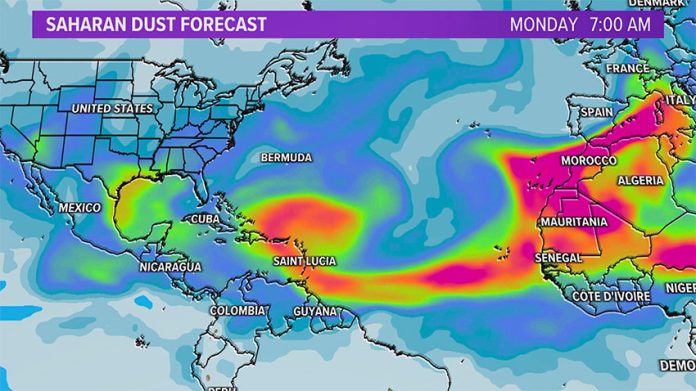The first dust cloud from the Sahara Desert has arrived in the Yucatán Peninsula in the annual meteorological event known as the Saharan Air Layer.
Each year, upwards of 60 million tonnes of dust from arid areas North Africa – made up of particles of iron, silicon, mercury and phosphorus, among other chemical elements – are dragged by wind currents 7,000 kilometers west to the Americas. The resulting cloud will sit above the peninsula until Monday causing misty, reddish skies before heading toward the Gulf of Mexico, Nuevo León and Coahuila. A second cloud will reach the peninsula on July 14.
Days are predicted to be sunnier, while nights and early mornings are likely to be colder than normal. The pattern could continue over the coming months.
The clouds are not expected to cause any risk to affected populations due to their low density although, according to the Pan American Health Organization (PAHO), more intense dust clouds can provoke allergies and asthmatic attacks from people who suffer from respiratory problems or immunosuppression. Persistent flu-like symptoms or allergies with no apparent cause have been linked to the natural phenomenon.
Authorities in Yucatán said the effects of the clouds will be similar to June last year: in addition to misty days and reddish skies it will bring a decrease in rainfall causing humidity to drop. Studies also suggest that the dry air from the dust stifles the formation of storms and hurricanes.
The dust also acts as a natural fertilizer and has been found to play a key role in restoring minerals to depleted rain forest soils in South America’s Amazon basin. However, research has shown that it may be harmful to coral reefs if it descends into the ocean before reaching land. One study found that the dust can trigger toxic algae blooms, also known as red tides, that have the capacity to kill large numbers of fish, shellfish, marine mammals and birds.
PAHO recommends that people with “chronic respiratory diseases (COPD, asthma), older adults, pregnant women and children should use respiratory protectors, such as masks or a damp cloth to cover their nose and mouth.”
The World Meteorological Organization also warned of the health risks. “Inhaling dust particles when the weather is hot and dry can damage the mucous membranes of the nose and throat, providing favorable conditions for a bacterial infection,” its advice read.
The dust can also spur the transmission of valley fever in northern Mexico and the southwestern United States.
